The small picturesque town of Dunfanaghy lies on the western side of Sheephaven Bay in northern Donegal. The golf course is situated on a narrow strip of land between Dunfanaghy and Portnablagh. Dunfanaghy Golf Club was founded in 1906 and affiliated to the Golfing Union of Ireland in 1920. According to the club's centenary book, golf may have been played there as early as the 1740s by British soldiers stationed at the barracks. The book, published in 2006 mentions the existence of a golf course connected to the Stewart Arms Hotel since 1886.
 The Stewart Arms Hotel (centre of picture)
The Stewart Arms Hotel (centre of picture)In the early days, golfers made their way along the town road and then turned left down the lane way where the little boy is standing in the foreground.
 Present day Dunfanaghy viewed from the seventeenth tee.
Present day Dunfanaghy viewed from the seventeenth tee.The original first tee (now the 18th tee) was located directly in line with the church spire.
 1897 advertisement for Stewart Arms Hotel listing golf as one of the attractions.
1897 advertisement for Stewart Arms Hotel listing golf as one of the attractions.The generally accepted view is that Harry Vardon designed the course in 1906. This seems reasonable, as he also raised the Rosapenna course to "championship dignity" in the Spring of the same year. The two courses are within an hours carriage ride of one another, so it's possible that he worked on both courses during this particular visit to Ireland.
There is little doubt that the course had been recently modified prior to Edgar S. Shrubsole's visit in 1908, as he wrote in his book
Picturesque Donegal that:
when the links are got in proper order, this course should rank high in the estimation of the most exacting golfers, for, although they are newly laid out, the turf is excellent quality, the greens are natural, and there are many natural bunkers.Shrubsole goes on to say that the 18 hole course
has been specially laid out by Mr. Sterritt for the use of his guests, thus casting doubt on the notion that Vardon designed the course in 1906. In addition, the course description given by Shrubsole bears little resemblance to the present day's course. One thing is certain, if Vardon did design the course in 1906, it has undergone significant alterations in the intervening years.
Vardon did return to Donegal in June 1910, but the primary purpose of his visit was to participate in a professional match at Rosapenna between John Ball Jnr., George Duncan and Alexander "Sandy" Herd. He may have visited Dunfanaghy at this time, or perhaps even later in 1927, when he re-designed the course at Bundoran.
Unfortunately the answers to these questions are not contained in the centenary book, so let's dispense with the speculation and proceed to describe the course as we find it today.
I should declare that I have a great fondness for Dunfanaghy; some would call it bias, or even blind devotion. I have always regarded it as a type of "feel good" course. The course provides plenty of opportunities for birdies, so one sometimes feels like a top class golfer. This feeling doesn't usually last long, as there are several holes where the course can claw back those hard earned low scores. Some golfers might say that the course is too short, but I disagree. The shortest par four is 283 mtrs, with the longest stretching to 392 mtrs. The solitary par five on the back nine is 500 mtrs, and the five par threes range from 124 mtrs to 209 mtrs long. The par is 68 (SSS 67) and the course measures 5300 mtrs.
Several holes have been stretched a little in recent years by moving some tees back a few mtrs where possible, so that it now plays about 200 mtrs longer than it did in the 1980s. Only two small modification have been made to the routing in the last thirty years; the second tee was moved in the 1980s, and the 6th tee was pushed back about 70 mtrs in the late 1990s or early 2000s. Some new bunkers have also been added.
 Dunfanaghy routing; holes 1-4, 11-18
Dunfanaghy routing; holes 1-4, 11-18 Dunfanaghy routing; holes 4-11
Dunfanaghy routing; holes 4-11The course played very firm and fast when I visited it recently. I don't recall seeing any sprinkler heads, but if there is an irrigation system in place, there was no evidence of it being used. The fairways were very firm and dry, and all approach shots had to be landed well short of the greens. I would describe the conditions as quintessentially links like.
HOLE 1: Trustee Four, 316 MTRS, PAR 4, S.I. 11.The first hole appears benign enough when one glances at the score card. At 316 mtrs, it shouldn't cause much trouble, but it does. Hard up against the right hand side of the hole is the OOB boundary. As if OOB isn't bad enough, one must also contend with a wind coming from the left that blows anything with "slice" written on it even further right. As we waited at the first tee while two threeballs hit off, it became obvious how magnetic the OOB is. One-in-three of the players hit their tee shots OOB.

The view from the first tee (above). The green lies in a direction just to the left of the bin in the centre of the photograph. The hole curves gently from right to left, so the ideal line off the tee is directly over the bin in the foreground. The green might be drivable if the wind is at your back.

A drain that is not visible from the tee, runs across the fairway approximately 150 mtrs from the tee. The left side of the fairway is guarded by a lone bunker and one should play to the right of it.

A drive that strays left and carries (180 mtrs) this recently added bunker will end up in rough that is not that troublesome. Considering that there's OOB to the right, the left side is not such a bad place to end up.
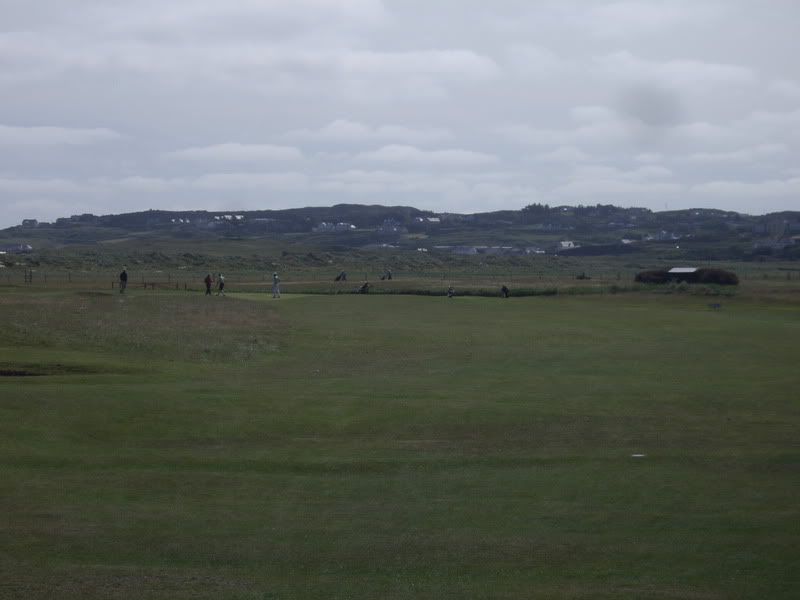
The view from about 180 mtrs out. The fairway is quite generous and one now gets a better idea of how the hole curves to the left.

The view back towards the clubhouse and first tee. The OOB stakes are visible on the left.

As with nearly all the greens at Dunfanaghy, the entrance is usually open and perfectly suited for the ground game. With such firm ground, the approach shot needs to land several yards short of the green, allowing the ball to roll the rest of the way to the flagstick. Watch out for the drain behind the green.

The view from the right side of the fairway. A good angle to approach today's pin position.

A view from just a little short and right of the green. If one managed to hit a huge drive, it now becomes clear that getting the pitch to stop close to the flag will not be so easy.

The view from right of the green. The drain to the rear of the green is no more that a few yards from the putting surface, so any approach hit too boldly will find a watery grave. One now appreciates that a "helping wind" is not really that helpful. Over clubbing on this hole will get you in big trouble.
HOLE 2: The Burn, 148 MTRS, PAR 3, S.I. 13.The second tee is situated just to the right of the first fairway. The hole runs in much the same direction as the first hole, but this was not always the case. The old tee was located to the left of the first green and the green was approached at a 60-70 degree angle to the present hole. The tee was relocated in the late 1980s, presumably the purpose being to bring the drain that curves around the right side of the second green more into play. This new tee location causes some safety issues, as the players walking from the first green to the second tee must walk back up the side of the first fairway. The new tee has robbed the course of a hole that played in a very different direction to all the others. As a result of this, the course now begins with the first six holes heading out in much the same direction.

The view of the second hole from the tee. It appears more intimidating than it really is.

The same drain that runs behind the first green is more apparent from the ladies tee.

As one approaches the drain, you also realise that there is more room between the drain and the front of the green. The club have built a number of stone bridges in recent years.

There are some nice small bumps and dips at the front and right side of the green.

A view of the green from the left side. This bunker is ready to catch any shot that is hit left off the tee.

Another look at the second green. This would have been the view that one had when looking back to the old second tee. The old tee was just above the flagstick and beyond the stone bridge in the background. The old tee is still being maintained, so I assume the club use it occasionally. The first green is visible in the background.

The meandering drain that makes a more dangerous re-appearance at the 13th.

A view from behind looking back towards the tee (in extreme left of picture). There is more room between the green and drain that runs along the right, than one sees when standing on the tee. The green is quite large with plenty of room for recovery on all sides.

A final look at the second green.
HOLE 3: Kill, 363 MTRS, PAR 4, S.I. 3.The third hole continues in the same direction is the second. At one time, this was the most difficult par four on the course, but that title is now held by the recently lengthened fifth hole.
The ideal line off the tee is down the left side of the fairway. The greenside bunker guards the right side of the green and the ridge to the right of the green throws everything either left or right. A drive hit down the right side of the fairway will leave the player with an extremely difficult approach shot if the flag is towards the front of the green. This solitary greenside bunker dictates the strategy off the tee, and is a lesson on how a hole can be made interesting with just one bunker.

A view of the third hole from the tee.

The fairway is quite generous and not without character.

The view from about 200 m from the green.

The left side of the fairway is the ideal position to approach the green. A fading approach shot is recommended from here.
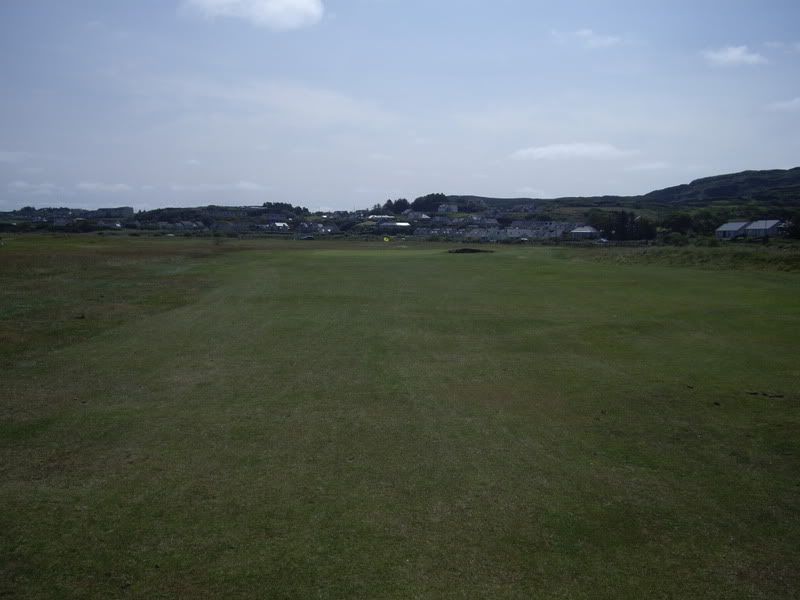
The scene from 120 mtrs out. Today's flag is positioned at the front; any shots landing on the green will be too strong.

At one time, the third hole shared the same fairway with the 12th hole that runs in the opposite direction. The two holes have now been separated by the insertion of a number of artificial looking mounds between both fairways. This is a view of the mounds (the 12th fairway is at right). In my opinion, the mounds are too high, look totally out of place, and were not necessary. This is after all, the flattest part of the golf course.

The ground leading up to the green slopes to the left ever so slighty, which ensures that a pitch shot from this position will be quite tricky.

A look back down the third fairway. The tee is located just to the right of the large copse of trees in the centre of the picture.
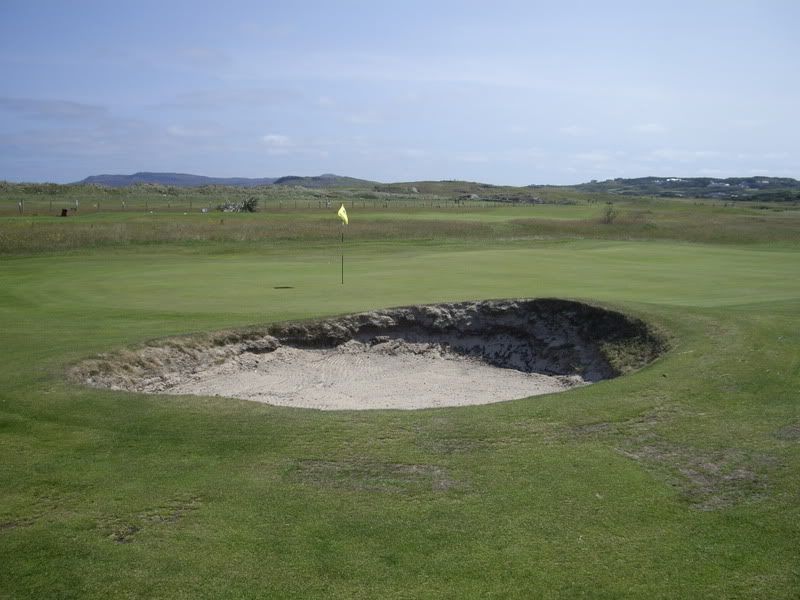
The green, which is perhaps the longest on the course, is also one of the most interesting. There are some lovely natural swales and slopes throughout the green. The left side of the green falls off into small depressions.

A final view of the green from the fourth tee. The 12th tee is in the background.
HOLE 4: Canyon, 347 MTRS, PAR 4, S.I. 5.And so our journey continues as we head out to the farthest point on the course. The fourth hole is another par four (there are 12 in total on the course) that plays very differently, depending on the wind direction.

The OOB fence is clearly visible from the tee, and this is the only real concern with the drive.
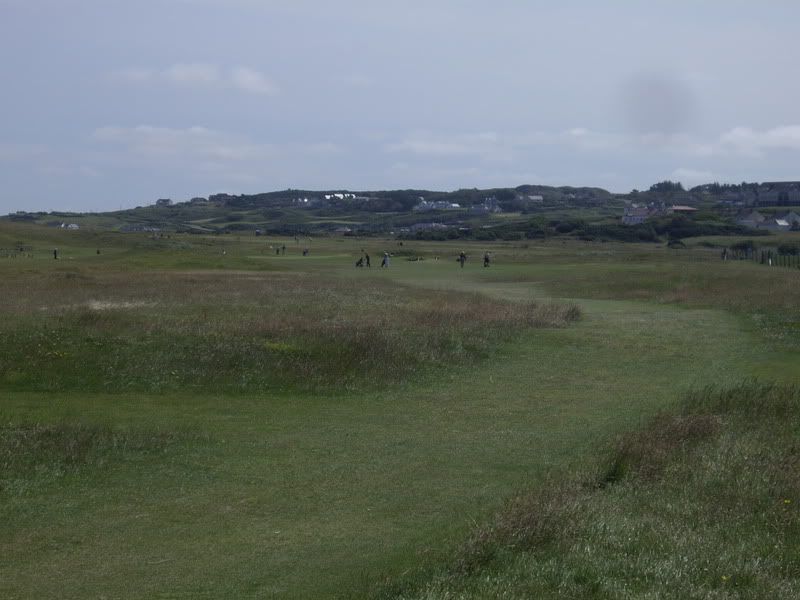
The holes curves gently to the left. As with the third and 12th holes, at one time the fourth hole shared the same fairway with the 11th hole that runs in the opposite direction. The two holes have now been separated by more artificial looking mounds between both fairways.
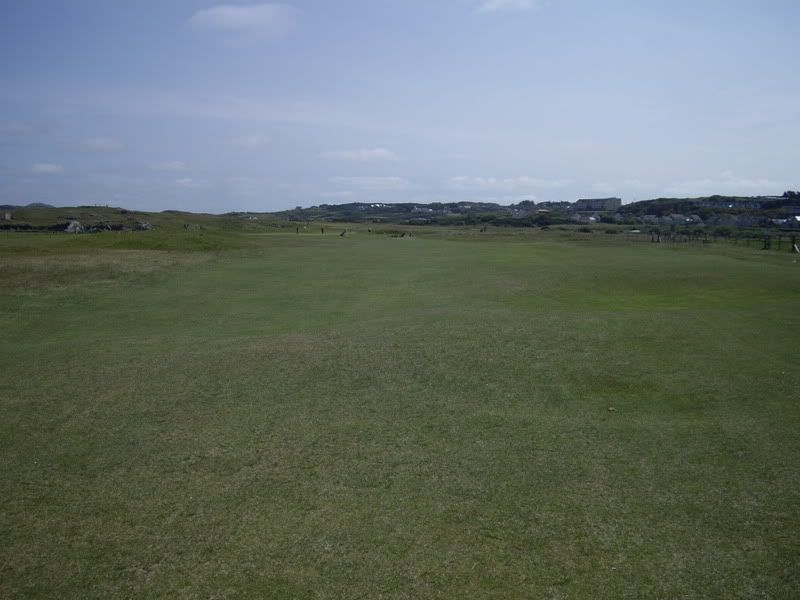
The view from about 180 mtrs from the green; another generous fairway. The golfers has no knowledge of the trouble that awaits 30 mtrs short of the green.
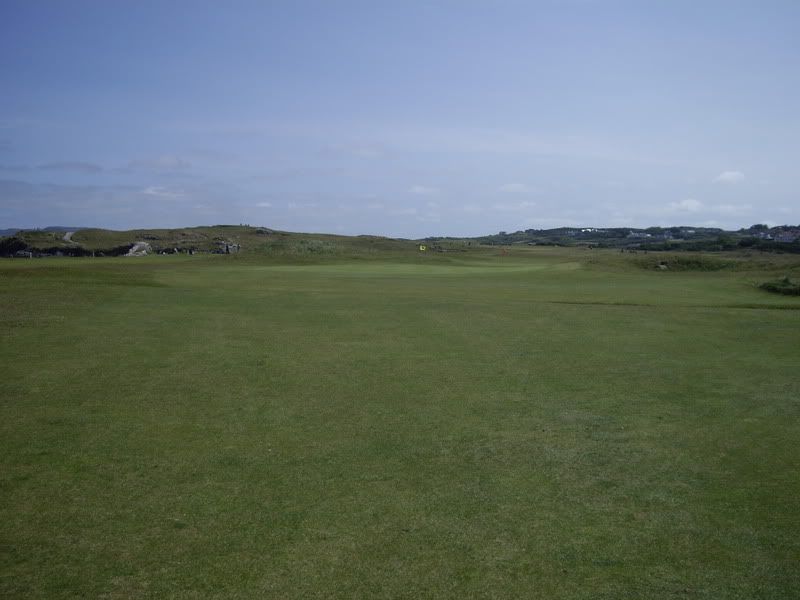
If you duffed or topped your approach shot to the green, you may be wondering as you walk towards the green, where your ball is and what is that dark line crossing the fairway. The stream only becomes visible when one is within 50 mtrs. In calm conditions, the stream may not pose a major problem, but if there is a stiff wind against, it becomes more of a concern.

The edges of the stream have now been stabilized, but in the 1980s, the banks were rough and sloped and the stream was wider and shallower. One had the possibility to play a recovery shot from the stream, but is no longer the case today. The green is set back about 30 m from the stream, so it's possible to hit this green, even when the wind is with you. The green is relatively flat and should not cause the golfer too much trouble. The red flag in the background is for the 10th green.

A look back down the fairway to the tee (situated just below the gabled house).

A view back down the fourth hole. The 11th hole is visible on the right side of the photograph.
HOLE 5: Breenagh Lodge, 330 MTRS, PAR 4, S.I. 9.The fifth hole is another shortish par four that dog-legs gently left. The fairway rises ever so slightly towards one of the most interesting greens on the course. The fairway sits on a raised plateau whose edge runs up the whole left side of the fairway. The main concern from the tee is the OOB to the right, but a pulled drive may leave the player in thickish rough and an obscured view of the green.

The view from the tee. The green is in the centre of the photograph, but the direction to take off the tee is towards the two gentlemen walking just right of centre.

Another generous fairway!
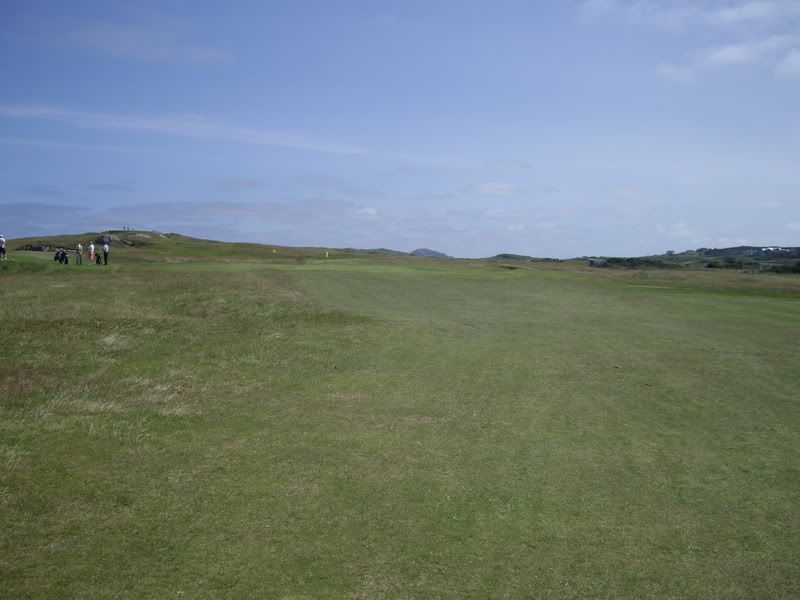
The fairway narrows about 50 mtrs from the green, but this should be of no concern to the player that is able to drive it 250+ mtrs, as the rough is not penal.

As one approaches the green, it becomes crystal clear that landing the second shot short and expecting it to run on to the green, was the wrong choice.

Whether man made or not, the trough like feature that extends across the front entrance of the green adds so much more to a hole that might otherwise be considered rather ordinary. I assume this feature is totally natural, but it just goes to show how such a simple feature can enhance a hole greatly.
Why don't we see features like this on modern courses?

The aerial route might be the best option if one finds himself just short of the green. But with the day's hole location, will the ball stop?

Perhaps a chip-and-run is in order.

A look back down the hole towards the tee (located beside the little white shed). The 10th hole is to the right. The green is packed with interest. Notice the ridge running diagonally across the green.

A second look at this undulating green.

A view of the green from the left side.